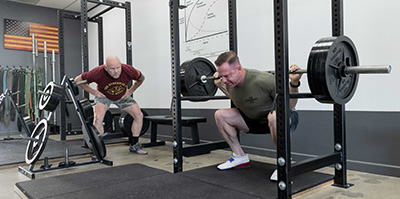Two Great Steaks You Aren’t Eating
by Michael Buckley, Owner of Ventura Meat Co.
Everyone who enjoys a good steak has heard of a Ribeye, Filet Mignon and of course the New York Strip. We’ve all had a nice T-Bone or a Porterhouse. Maybe you like Sirloin, or even the illusive Chuck Eye Steak.
As the owner of a butcher shop I can tell you that “steak” is an ambiguous term. Regardless of what type of steak you are the most familiar with or enjoy eating, we all understand “steak” to be a cut of beef that is cooked over a very hot heat source for a brief amount of time (unless of course you’re the Liver King and just eat it raw).
These terms may be fine for most people, but as a professional Butcher I feel the need to go into a little more detail. Generally speaking, a steak should be made with a relatively tender muscle. But cows have over 100 different muscles, from various places on the steer. They all have different properties that affect what some studies refer to as “processing characteristics, and consumer acceptability”. You can interpret that as how these “relatively tender” muscles should be cooked, and whether or not consumers will even buy them (most of what I care about as the business owner).
Experience has taught me that familiarity is the key to consumer acceptability. So, if we familiarize ourselves with more than just the normal supermarket steaks, we can enjoy more of the delicious muscles these majestic bovid mammals have to offer. It’s kind of like barbell training, if you don’t know how safe, effective, and life changing it can be then you will never pick one up. But if you do, it will change your life.
Enter the Hanger Steak, and the Flat Iron Steak. I generally think of these steaks as ‘restaurant cuts’, as you are much more likely to find them in that setting than you would in a retail setting. At The Ventura Meat Company we are trying to buck that trend. Because it is my belief that these two steak cuts should be in everyone’s steak consuming routine.
In this article, we are going to cover the first of the two: The Hanger Steak.
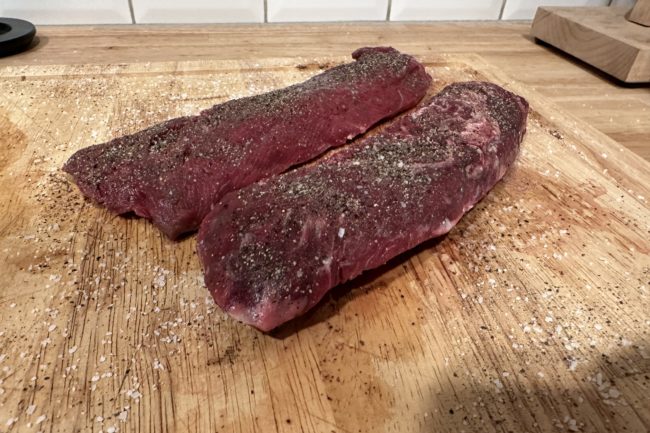
I always like to break the terminology down when trying to understand a certain cut. Why is it even called that to begin with? Does it have any other names? Sometimes this approach can lead directly to an answer for both of those questions. The Hanger Steak is also referred to as the ‘Hanging Tender’. Now we’re getting somewhere.
It should go without saying that ‘tender’ is a dead giveaway. It’s the word “tender” that qualifies it as a steak. The “hanger” terminology just informs us about location. This muscle literally hangs from the animal’s diaphragm.
Having broken down many beef carcasses I can tell you that you will find it on the forequarter. I can picture a split carcass now and I can tell you the terminology is correct, it just hangs there. This is why it’s tender. It does little to no structural work and has less connective tissue than many other cuts of meat which makes it extremely tender and very tasty.
The Hanger Steak used to be called The Butcher’s Steak, because when the folks used to exclusively purchase beef in quarters or halves (before grocery stores had meat departments), butchers would keep this cut for themselves. If you try a Hanger Steak… you’ll know why they kept this for themselves!
Cooking a Hanger Steak is very easy. I would recommend a Cast Iron pan (this is not a plug for Grant’s cast iron plates, but I bet a 25lbs plate would work just as well) as it will not take very long to cook. You could can also use a grill but I would not fire one up just to cook one steak.
HOW TO COOK A HANGER STEAK
Preheat your cast iron skillet either on high heat or in your oven at 425 degrees. Bring your steaks to room temperature and season with salt and pepper or your favorite steak seasoning. For most beef I find that Salt and Pepper does the trick and lets you enjoy the properties of the meat but this is America, so you should season them however you like.
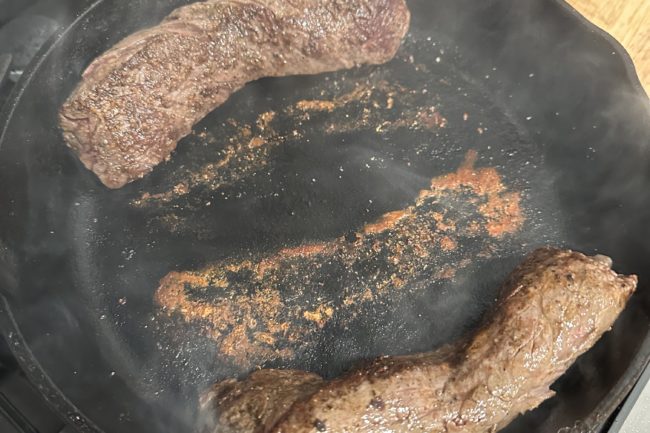
Once the steaks are at room temperature and the pan is piping hot add a light layer of olive oil and then drop your steaks into the pan. I like to put the hanger steaks on the edge of the pan so that half of the pan remains empty. This way the empty side of the pan will be ripping hot when you flip the steaks after 2-3 minutes of initial searing. Remember to rotate the steaks when you flip to the other side. The steak will almost become tubular but it will still maintain a “top” and “bottom”.
If you’re using a meat thermometer and you’re still not at desired temperature (I recommend medium rare 130-135 degrees) then you can take the entire pan and place it in the oven until it reaches 130. You can also flip the meat again and wait for the desired temperature but personally I prefer these steaks without too much of a “sear”.
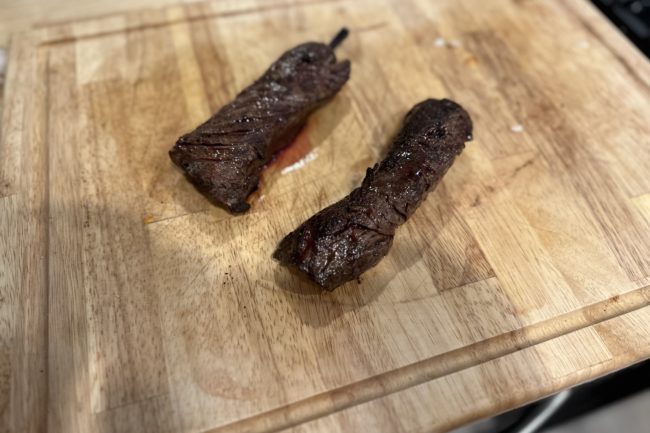
The whole cooking process will take you about 10 minutes. Let them rest for a few minutes and then slice against the grain. Once you do, you’ll be calling your local butcher and seeing if he’s worth his salt (pun intended) and has some for you to purchase. I must also mention that the Hanger Steak is very versatile! On top of cooking it as just a steak it’s also great for fajitas or even beef and broccoli. It is easy to cook and it has BIG BEEF FLAVOR.
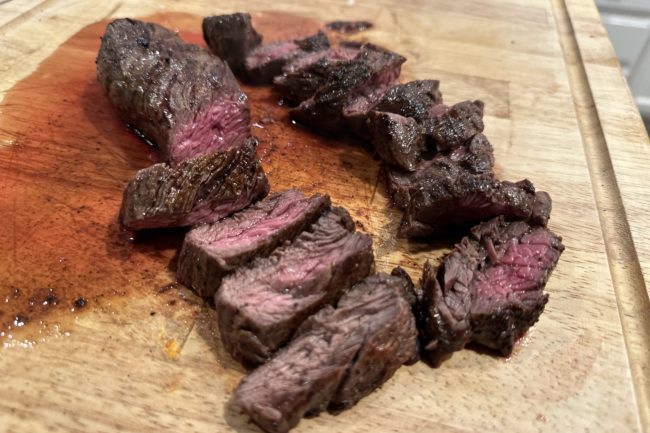
YOU NEED TO ADD THIS STEAK TO YOUR REPERTOIRE! Talk to your butcher, if he won’t get you one… well it’s similar to when a gym won’t let you use chalk… either find a new gym or build your own!
A note on the author:
Michael Buckley runs The Ventura Meat Co. and has been training with The Strength Co. using live online coaching for almost two years. During that time he has improved his body composition and has achieved a personal best on all of “the big four” lifts.

Michael is 45 years old , 5’ 8” and currently 163 lbs. His all time best lifts are a 320 lbs Squat, a 225 lbs Bench, a 135 lbs Press, and a 345 lbs Deadlift. Mike trains 3 times a week out of his garage and never misses a workout. He finds that lifting improves his ability to run his business and enjoy day to day activities.

